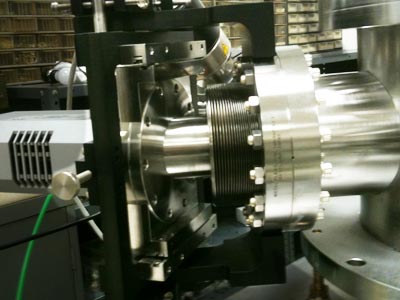
Flat Field for XUV, Soft X-ray and Extreme Ultraviolet (EUV)
McPherson Model 251MX aberration corrected flat field spectrometer uses spherical substrate gratings with aspheric wave-front recording for an aberration corrected, high resolution spectrometer working through the soft x-ray region. Ideal for soft x-ray, extreme UV (EUV) and vacuum ultraviolet analysis. The long focal length and straight spectral lines provide excellent spectral resolution. High quality gratings are readily available and to match your energy range of interest. The Model 251MX is ideal for direct detection XUV sensitive CCD detectors for fast, easy high-energy spectra. Microchannel plate (MCP) intensifiers are available for systems that require gating or when the fundamental wavelength in HHG experiments should be rejected.
Model 251MX PDF Data Sheet | Model 251MX Grating Selection
| Optical Design | McPherson Model 251MX Spectrograph |
| Focal Plane Length | ~25mm |
| Angle of Incidence | 87 degrees (< 3 degrees grazing) |
| Detector Position | micrometer slide and rotatable |
| Grating Mount | 2-position, adjustable in vacuum |
| Zero Order Baffle | standard, adjustable in vacuum |
| Entrance Slit | continuously variable from 10um to 3mm, adjustable in vacuum |
| Wavelength Range | refer to grating of interest for range |
| Grooves/mm | 120 | 300 | 1200 | 2400 |
| Deviation Angle Degrees | 170 | 170 | 170 | 174.4 |
| Resolution (nm) | ~ 0.3 | ~ 0.12 | ~ 0.028 | ~ 0.01 |
| Focal Plane Width (mm) | 25 | 25 | 25 | 20 |
| Spectral Range (nm) | 50 to 200 | 20 to 80 | 5 to 20 | 1 to 5 |
| Spectral Range (eV) | 25 to 6 | 65 to 15 | 248 to 62 | 1240 to 248 |




Flat field aberration corrected toroidal grating spectrometer fills a 40mm focal plane ideal for microchannel plate intensifiers. Compact and versatile most are in use in tokamak plasma research, some now for high harmonic generation and attosecond laser physics. Versions exist with dual and triple grating turrets, back-to-back diffraction gratings for simultaneous, dual-range monitoring, rocking mechanisms to scan large plasma sections and more.
For a general purpose laboratory instrument, greater flexibility, or astrophysics instrument calibration (for example) consider the Rowland circle design grazing incidence system Model 248/310G. It provides most flexibility with respect to wavelength range. Many grating choices are available and it delivers excellent spectral resolution.
Call to discuss the deatils of your application today.
This spectra was collected with the Model 251MX and a Princeton Instruments PIXIS CCD. Coarse 300 g/mm grating used for the He and H data. 2400 g/mm for the MgO and Al-K data. 1200 g/mm aberration corrected flat field grating for the rest. Light source is windowless hollow cathode and a soft x-ray (SXR) electron impact source.
Call 1-978-256-4512 to discuss your XUV and EUV application today!